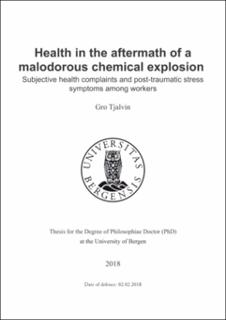| dc.contributor.author | Tjalvin, Gro | en_US |
| dc.date.accessioned | 2018-02-13T08:39:36Z | |
| dc.date.available | 2018-02-13T08:39:36Z | |
| dc.date.issued | 2018-02-02 | |
| dc.identifier.isbn | 978-82-308-3848-8 | en_US |
| dc.identifier.uri | https://hdl.handle.net/1956/17385 | |
| dc.description.abstract | Background: A chemical explosion in an oil tank took place in an industrial harbour area in Norway, in May 2007. Nobody was killed in the accident, but a malodorous environmental pollution was emitted, and spread in the vicinity. The foul-smelling pollution mainly comprised of mercaptans and other sulphurous compounds, which have very low odour thresholds compared to their hazardous thresholds. The clean-up operation started the following day, but was not completed until February 2010. Meanwhile the unpleasant smell was continuously present in the area. Aims: The main aim of this thesis was to study long-term health effects among workers in the aftermath of a chemical explosion that emitted malodorous sulphurous compounds. The first objective was to assess whether employees in the industrial area and cleanup workers had more subjective health complaints than controls one and a half years after the oil tank explosion. The second objective was to assess whether the subjective health complaints in this group declined over a four-year period following the explosion. The third objective was to investigate whether perceived smell related to the malodorous environmental pollution was a determinant of subjective health complaints and post-traumatic stress symptoms among employed adults, when the malodorous pollution was present at the explosion site, and after pollution clean-up. Material and methods: One and a half years after the accident, all residents living within six km to the explosion site and the whole population working in the industrial harbor area or participating in the firefighting or clean-up operation were invited to participate in a health survey including a questionnaire and a clinical examination. Inhabitants, matched by gender and age to the working population and the residents, and living 20-30 km away from the explosion site, were invited as controls. Of the total 1016 persons who were invited, 734 persons decided to participate (response rate 72 %). This thesis is based on sub-populations from this study. From the main cohort, the employees in the industrial area, the clean-up workers and controls were included in a cross sectional study using the Subjective Health Complaints Inventory (SHC) in 2008. Similar data were obtained in 2012, and were analysed by a linear mixed effects model in a longitudinal study. Next, all employed adults from the main cohort were divided into high and low odour score groups based on an individual odour score that was computed as the percentage of months each participant had noticed the specific incident-related odour. Questionnaire data from the Subjective Health Complaints Inventory (SHC) and the Impact of Event Scale-Revised (IES-R), both validated instruments, were analysed using a mixed effects model in a longitudinal study involving data from when the malodorous pollution was present until three years after pollution clean-up (2008, 2010 and 2012, respectively). Results: Employees in the industrial area and clean-up workers reported significantly more subjective health complaints, particularly neurological symptoms, compared to controls in 2008. In the longitudinal study, subjective health complaints among employees in the industrial area and clean-up workers declined over a four-year period following the explosion, but these workers still had significantly more neurological symptoms compared with controls in 2012. For the controls there were no significant changes. In the study based on perceived smell, employed adults in the high odour score group reported more subjective health complaints and post-traumatic stress symptoms than those in the low odour score group, even after the pollution was eliminated. Conclusion: This study showed a higher prevalence of health complaints such as sadness/depression, headache, sleep problems and tiredness among employees in the industrial area and clean-up workers, compared to controls whot lived more than 20 kilometres away from the explosion site. A reduction of these complaints during the study period could be attributable to reduced exposure to the foul-smelling pollutants, the course of time since the accident, or both. Additional assessments concluded that perception of the incident-related odour was a determinant of subjective health complaints as well as post-traumatic stress symptoms. These associations persisted for three years after the malodorous environmental pollution was removed from the area. This might indicate that early clean-up is of importance in order to avoid lasting health effects following malodorous chemical spills. The findings of this doctoral work indicate that health complaints might be related to malodorous environmental pollution even if exposure levels are considered as low compared to occupational exposure limits. | en_US |
| dc.language.iso | eng | eng |
| dc.publisher | The University of Bergen | eng |
| dc.relation.haspart | Paper I: Tjalvin G, Hollund BE, Lygre SH, Moen BE, Bråtveit M: Subjective Health Complaints among Workers in the Aftermath of an Oil Tank Explosion. Arch Environ Occup Health. 2015;70(6):332-40. Full text not available in BORA due to publisher restrictions. The article is available at: <a href="https://doi.org/10.1080/19338244.2014.918929" target="blank">https://doi.org/10.1080/19338244.2014.918929</a> | en_US |
| dc.relation.haspart | Paper II: Tjalvin G, Lygre SH, Hollund BE, Moen BE, Bråtveit M: Health complaints after a malodorous chemical explosion: a longitudinal study. Occup Med (Lond). 2015 Apr;65(3):202-9. The article is available at: <a href="http://hdl.handle.net/1956/17384" target="blank">http://hdl.handle.net/1956/17384</a> | en_US |
| dc.relation.haspart | Paper III: Tjalvin G, Magerøy N, Bråtveit M, Lygre SH, Hollund BE, Moen BE: Odour as a determinant of persistent symptoms after a chemical explosion, a longitudinal study. Ind Health. 2017 Apr 7;55(2):127-137. The article is available at: <a href="http://hdl.handle.net/1956/17383" target="blank">http://hdl.handle.net/1956/17383</a> | en_US |
| dc.title | Health in the aftermath of a malodorous chemical explosion: Subjective health complaints and post-traumatic stress symptoms among workers | en_US |
| dc.type | Doctoral thesis | |
| dc.rights.holder | Copyright the Author. All rights reserved | |
| dc.identifier.cristin | 1558336 | |
